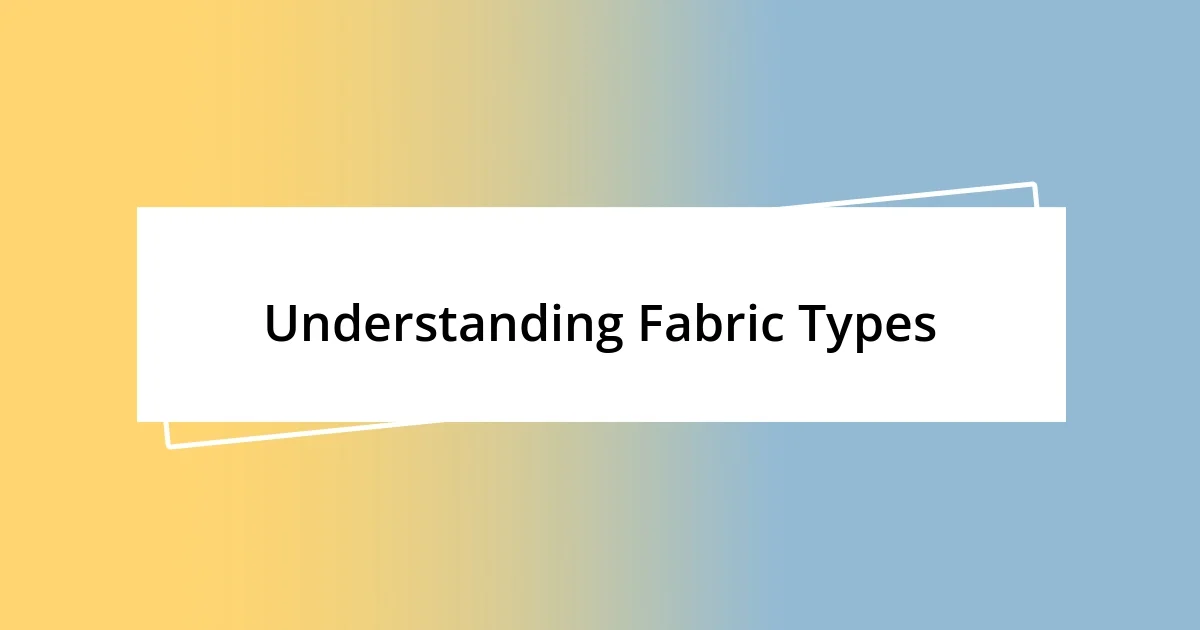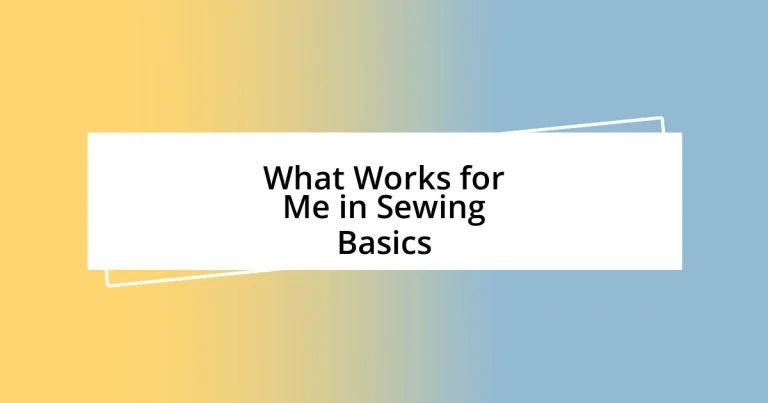Key takeaways:
- Sewing basics involve mastering fundamental skills like understanding tools, reading patterns, and executing basic techniques, which are essential for any beginner.
- Essential tools include a reliable sewing machine, appropriate needles, various threads, and cutting tools, all of which enhance the sewing experience and ensure quality results.
- Avoid common mistakes such as not prewashing fabric and failing to test tension settings, and focus on proper finishing techniques and personalizing projects for a professional touch.

What are Sewing Basics
Sewing basics encompass fundamental skills and techniques that form the foundation of this rewarding craft. Whenever I teach someone to sew, I emphasize the importance of understanding the tools—like needles, thread, and fabric. It’s fascinating how something as simple as a needle can have such an impact on the outcome of a project, right?
One key aspect of sewing basics is learning how to read a pattern. I remember the first time I tackled a garment pattern; it felt overwhelming. But once I grasped the symbols and terminology, such as “notches” or “seam allowances,” everything fell into place. It’s amazing how empowering it can be to decode a pattern, transforming a jumble of paper pieces into a beautiful piece of clothing.
Furthermore, mastering basic sewing techniques like straight seams, hemming, and buttonholing is crucial. At the beginning of my sewing journey, those tasks seemed daunting, yet every small success I had fueled my passion. I often ask myself: how can something so straightforward bring such joy? And the answer lies in the satisfaction of transforming raw materials into something uniquely yours.

Essential Sewing Tools
When I first delved into sewing, I quickly learned that having the right tools can make all the difference. As my collection of essential sewing tools grew, I could see my confidence building. It was like each new item in my sewing kit unlocked the potential for different kinds of projects.
Here’s a compact list of the essential tools that I believe every beginner should have on hand:
- Sewing machine: This is where the magic happens. A reliable machine can make sewing fun and efficient.
- Needles: Different needles for different fabrics are crucial. Trust me, using the right needle can eliminate many headaches.
- Thread: I prefer to keep a variety of colors handy; it sparks creativity!
- Scissors: Invest in a good pair; they are worth every penny.
- Measuring tape: Accurate measurements are the foundation of a well-fitted garment.
- Pins and pin cushion: These help keep everything in place while you sew.
- Seam ripper: Mistakes happen to the best of us; a seam ripper is essential for quick fixes.
- Fabric marking tools: Whether it’s chalk or friction pens, marking is key for precision.
Having these tools within reach has transformed my sewing experience into something much more enjoyable. Each piece in my toolkit feels like a friend who’s there to support me, guiding me through each stitch and seam.

Understanding Fabric Types
Understanding various fabric types is essential for every sewing enthusiast. Each fabric behaves differently under a needle, and I can’t stress enough how much this affects the final outcome of your projects. When I started out, I was often drawn to the beautiful patterns and colors of fabrics without considering their composition. A moment that stands out for me was when I misjudged a project using a stiff cotton when a soft, flowing rayon would have been perfect. The difference in drape and ease of sewing was like night and day!
Different materials serve unique purposes. For example, I often rely on cotton for its versatility and ease of care. It was the first fabric I worked with and, honestly, it helped me develop my skills. On the other hand, silk, although gorgeous, requires a gentle touch and good techniques—I learned that the hard way when I had to redo a whole sleeve because it slipped so easily under the machine. So, understanding the basics of fabric types can truly empower your creativity.
As you dive deeper into sewing, you’ll encounter a wide range of fabrics, each with its characteristics. I often find myself experimenting with blends, too, like cotton-polyester. They combine the breathability of cotton with added durability. This exploration not only enhances my skills but also keeps the creative process exciting. I encourage you to touch and feel different fabrics when you can; it’s an experience that sparks inspiration and makes your projects more enjoyable.
| Fabric Type | Characteristics | Best For |
|---|---|---|
| Cotton | Breathable, easy to sew, versatile | Clothing, quilting, home decor |
| Silk | Luxurious, delicate, requires careful handling | Dresses, blouses, formal wear |
| Wool | Warm, heavy, great structure | Coats, sweaters, tailored pieces |
| Rayon | Soft, drapes well, can be tricky to sew | Dresses, lightweight blouses |
| Denim | Durable, heavy, comes in different weights | Jeans, jackets, bags |
| Polyester | Strong, wrinkle-resistant, varies in texture | Activewear, linings, blends |

Mastering Basic Stitches
Mastering the basic stitches is a thrilling journey in sewing. When I first tackled hand stitches, I remember my excitement mixed with a dash of anxiety. I’d often find myself asking, “Will this turn out right?” But with practice, I realized that mastering stitches like the straight stitch and zigzag stitch opened up a world of possibilities. Each stitch feels like another tool in a writer’s kit, allowing for more intricate and varied storytelling through fabric.
As I continued to practice, I discovered the beauty of the backstitch. It’s amazing how such a simple technique can provide strength and durability to seams. I vividly recall the moment I finished a project using the backstitch for the first time; it felt like an accomplishment! I learned how this stitch, often regarded as a beginner’s technique, can elevate a project and serve both functional and aesthetic purposes. The satisfaction that comes from perfecting a single stitch can be surprisingly profound.
I can’t emphasize enough the importance of practicing these basic stitches until they feel second nature. It’s like learning to ride a bike—once you get the hang of it, you can glide with confidence. A tip that worked wonders for me was to use scrap fabric during practice sessions. This is a safe space to experiment, make adjustments, and discover what works best for you. What stitches resonate with you? I urge you to find your rhythm and enjoy the process; each stitch is a step towards creating something uniquely yours.

Tips for Accurate Cutting
When it comes to accurate cutting, the right tools make all the difference. I vividly remember the frustration of trying to cut fabric with dull scissors—it just never felt precise. Switching to a high-quality pair of fabric shears transformed my cutting game completely. They glide through the material smoothly, and it’s remarkable how much cleaner my edges look now. Have you ever felt the difference a sharp scissor can make? Trust me; it’s a game-changer.
Using a cutting mat and a rotary cutter is another tip I swear by. The first time I used this technique, everything fell into place. I could get straight, even cuts, and the process sped up significantly. I also recommend using a ruler to guide your cuts; it provides that extra assurance, especially when dealing with complex patterns. It’s incredible how much more confident I felt in my work afterward, and I’d love for you to experience that, too.
Finally, always remember to double-check your measurements before cutting. I’ve made the mistake of being a little too eager, and ended up with pieces that didn’t match. Every time I remind myself, “Measure twice, cut once,” I save myself from unnecessary frustration. Think about how great it is to know you’ve got it right before making that final cut—it’s such a satisfying feeling!

Common Sewing Mistakes to Avoid
Sewing can be such a joyful craft, but I’ve definitely stumbled over my fair share of mistakes. One of the biggest slip-ups I made early on was not testing my tension settings. I remember the first time I had to unpick a seam because the fabric gathered like a frilly cupcake. It was frustrating! Testing on a scrap piece of fabric can save you from those heart-wrenching moments later in your project. Have you ever faced a similar situation? I think we can all relate to that sinking feeling!
Another pitfall that many beginner sewists, myself included, fall into is not prewashing fabric. The first time I completed a lovely dress and then watched it shrink in the wash? Let’s just say I was devastated. Prewashing not only prepares the fabric for any surprises later on but also helps prevent colors from bleeding into one another. It’s a simple step, yet it can truly impact the longevity and appearance of your finished piece. I find it worth the extra time, and I promise you will too!
Overcrowding the sewing machine with fabric is a frequent mistake I’ve seen. In my eagerness to finish a project quickly, I’ve crammed too many layers under my presser foot. This resulted in skipped stitches and uneven seams—an absolute nightmare! Now, I always remind myself to take it slow. A steady approach not only enhances control but leads to better results. Have you ever had a project turn into chaos? I bet you can relate to that!

How to Finish Your Projects
Finishing your sewing project can be an exhilarating experience, but it doesn’t come without some necessary steps. I still remember the day I finally sewed my first quilt and the anticipation of seeing it all come together. After piecing everything, I realized that investing time in properly pressing each seam made a world of difference. When I took those few extra moments to iron, the vibrant patterns sprang to life, and I couldn’t help but smile. Have you finished a project only to feel it was flat? Pressing can change that!
Another key part of the finishing process is the final stitching techniques. I’ve flirted with various methods, but I always come back to using either a zigzag stitch or serging the edges to prevent fraying. The first time I finished a garment this way, the edges looked so professional that I felt like a sewing magician! The sense of accomplishment was incredible. Do you have a favorite edge finish? I suggest experimenting until you find the one that resonates with you.
Lastly, adding those finishing touches truly brings your project to life. I love hand-stitching labels or embellishments for that personal flair. One time, I stitched a little heart loop on a purse I made, and it became a talking point at a friend’s gathering. It made the bag uniquely mine! Small details can evoke emotion and memories, turning a simple project into something special. How do you like to personalize your creations? Trust me; those little additions make all the difference.














